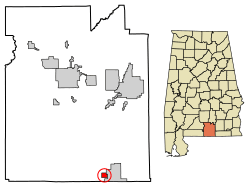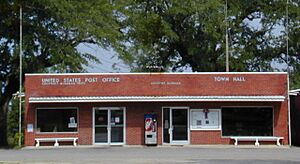Lockhart, Alabama facts for kids
Quick facts for kids
Lockhart, Alabama
|
|
|---|---|
|
Town
|
|

Location of Lockhart in Covington County, Alabama.
|
|
| Country | United States |
| State | Alabama |
| County | Covington |
| Area | |
| • Total | 1.13 sq mi (2.92 km2) |
| • Land | 1.09 sq mi (2.82 km2) |
| • Water | 0.04 sq mi (0.10 km2) |
| Elevation | 289 ft (88 m) |
| Population
(2020)
|
|
| • Total | 445 |
| • Density | 409.01/sq mi (157.90/km2) |
| Time zone | UTC−6 (Central (CST)) |
| • Summer (DST) | UTC−5 (CDT) |
| ZIP code |
36455
|
| Area code | 334 |
| FIPS code | 01-43816 |
| GNIS feature ID | 0121944 |
Lockhart is a small town located in Covington County, Alabama, in the United States. In 2020, about 445 people lived there.
Contents
Where is Lockhart?
Lockhart is in the southern part of Covington County, Alabama. It's only about one mile north of the Florida state line. The town of Florala is right next to Lockhart, to its east.
The town covers a total area of about 2.9 square kilometers (1.1 square miles). Most of this area is land, about 2.8 square kilometers (1.09 square miles). A small part, about 0.1 square kilometers (0.04 square miles), is water.
Lockhart's History
Lockhart started around 1904. This was when the Jackson Lumber Company built a large mill there. The community became a "company town," meaning the company owned most of it. Many streets in Lockhart were named after Native American tribes.
The Lumber Mill
The mill was built to cut down the many yellow pine trees in the area. This forest was known as the "Jackson Tract." The town was named after Charles Lockhart, a rich businessman from Pittsburgh, Pennsylvania. He was involved with Standard Oil.
By 1912, the mill was very busy. It employed about a thousand workers and ran all day and night. At that time, Lockhart had the biggest lumber mill in the United States. The wood for the famous Waldorf-Astoria Hotel in New York City even came from Lockhart.
Challenges and Changes
In 1903, the mill faced a problem involving workers. Some immigrant workers were kept against their will in a fenced area. Company officials were punished for this, but their sentences were reduced.
The mill used two major railroads, the Central of Georgia Railroad and the Louisville and Nashville Railroad. These connected through nearby Florala, Alabama. The mill closed in 1940. There are two main ideas why this happened. One reason might be that many workers joined the military before World War II. This caused a shortage of people to work at the mill.
Another reason is that the company might have sold its land to the residents. This happened after they cut down all the trees and decided not to wait for new ones to grow. The Jackson Lumber Company also gave a lot of land to the state. This land was replanted and developed by the Civilian Conservation Corps. It became Geneva State Forest in Geneva County. This land had little value after all the trees were cut down. During the Great Depression, the company returned it to the state instead of paying taxes on it.
People of Lockhart

The number of people living in Lockhart has changed over the years.
| Historical population | |||
|---|---|---|---|
| Census | Pop. | %± | |
| 1940 | 910 | — | |
| 1950 | 819 | −10.0% | |
| 1960 | 799 | −2.4% | |
| 1970 | 698 | −12.6% | |
| 1980 | 547 | −21.6% | |
| 1990 | 484 | −11.5% | |
| 2000 | 548 | 13.2% | |
| 2010 | 516 | −5.8% | |
| 2020 | 445 | −13.8% | |
| U.S. Decennial Census 2013 Estimate |
|||
In 2000, there were 548 people living in Lockhart. These people lived in 229 homes. About 147 of these were families. The town had about 504 people per square mile.
Many different people live in Lockhart. In 2000, about 74.8% of the people were White. About 23.9% were Black or African American. A small number were Native American or Pacific Islander. About 2.2% of the people were Hispanic or Latino.
Families and Ages
About 30.6% of homes had children under 18 living there. About 48.5% of homes were married couples. About 11.8% had a female head of household with no husband.
The average home had 2.39 people. The average family had 3.01 people. The town's population included people of all ages. About 25.4% were under 18. About 16.4% were 65 or older. The average age in Lockhart was 39 years old.
Education in Lockhart
- WS Harlan Elementary School (opened in 1903)
Famous People from Lockhart
- Charles LeMaistre: A doctor and teacher.
- George LeMaistre: A lawyer, banker, and professor. He was also the chairman of the Federal Deposit Insurance Corporation.
- William March: An author known for his books The Bad Seed and Company K. He used his mother's maiden name, March, as his pen name. His real name was William Campbell.
- Art White: A former offensive lineman in the National Football League. He played for the New York Giants and the Chicago Cardinals.
See also
 In Spanish: Lockhart (Alabama) para niños
In Spanish: Lockhart (Alabama) para niños

